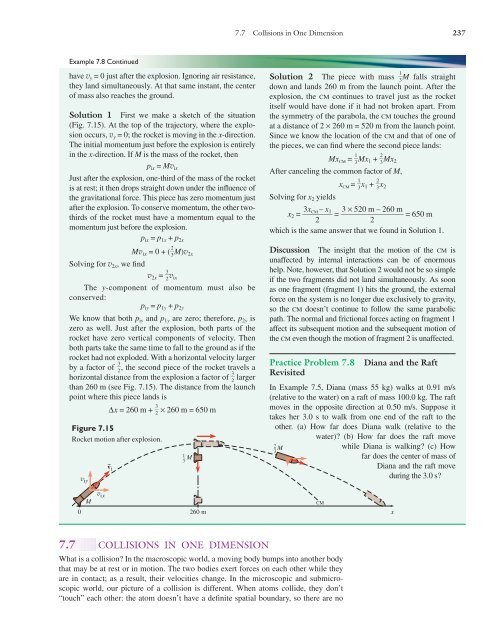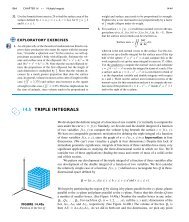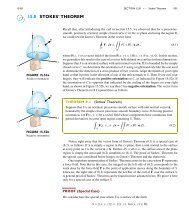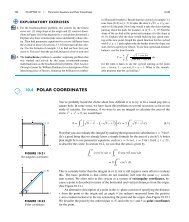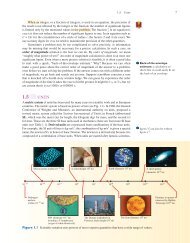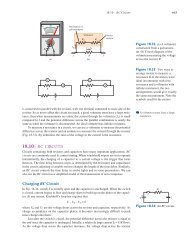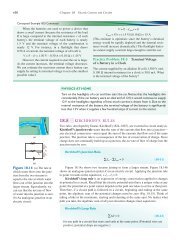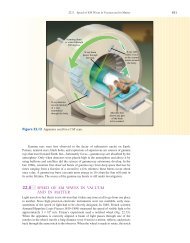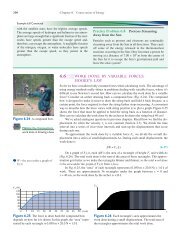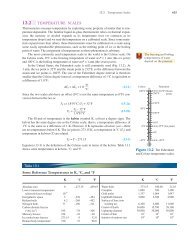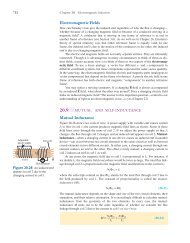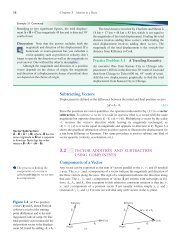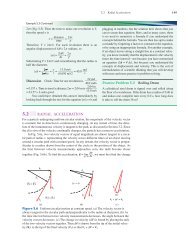COLLISIONS IN ONE DIMENSION
COLLISIONS IN ONE DIMENSION
COLLISIONS IN ONE DIMENSION
You also want an ePaper? Increase the reach of your titles
YUMPU automatically turns print PDFs into web optimized ePapers that Google loves.
7.7 Collisions in One Dimension 237<br />
Example 7.8 Continued<br />
have v y = 0 just after the explosion. Ignoring air resistance,<br />
they land simultaneously. At that same instant, the center<br />
of mass also reaches the ground.<br />
Solution 1 First we make a sketch of the situation<br />
(Fig. 7.15). At the top of the trajectory, where the explosion<br />
occurs, v y = 0; the rocket is moving in the x-direction.<br />
The initial momentum just before the explosion is entirely<br />
in the x-direction. If M is the mass of the rocket, then<br />
p ix = Mv ix<br />
Just after the explosion, one-third of the mass of the rocket<br />
is at rest; it then drops straight down under the influence of<br />
the gravitational force. This piece has zero momentum just<br />
after the explosion. To conserve momentum, the other twothirds<br />
of the rocket must have a momentum equal to the<br />
momentum just before the explosion.<br />
p ix = p 1x + p 2x<br />
Mv ix = 0 + ( 2 3 M)v 2x<br />
Solving for v 2x , we find<br />
v 2x = 3 2 v ix<br />
The y-component of momentum must also be<br />
conserved:<br />
p iy = p 1y + p 2y<br />
We know that both p iy and p 1y are zero; therefore, p 2y is<br />
zero as well. Just after the explosion, both parts of the<br />
rocket have zero vertical components of velocity. Then<br />
both parts take the same time to fall to the ground as if the<br />
rocket had not exploded. With a horizontal velocity larger<br />
by a factor of 3 2 , the second piece of the rocket travels a<br />
horizontal distance from the explosion a factor of 3 2 larger<br />
than 260 m (see Fig. 7.15). The distance from the launch<br />
point where this piece lands is<br />
∆x = 260 m + 3 2 × 260 m = 650 m<br />
Figure 7.15<br />
Rocket motion after explosion.<br />
2 M<br />
1<br />
– M<br />
3<br />
v i<br />
v iy<br />
v ix<br />
Solution 2 The piece with mass 1 3 M falls straight<br />
down and lands 260 m from the launch point. After the<br />
explosion, the CM continues to travel just as the rocket<br />
itself would have done if it had not broken apart. From<br />
the symmetry of the parabola, the CM touches the ground<br />
at a distance of 2 × 260 m = 520 m from the launch point.<br />
Since we know the location of the CM and that of one of<br />
the pieces, we can find where the second piece lands:<br />
Mx CM = 1 3 Mx 1 + 2 3 Mx 2<br />
After canceling the common factor of M,<br />
x CM = 1 3 x 1 + 2 3 x 2<br />
Solving for x 2 yields<br />
x 2 = 3x CM – x<br />
1<br />
= 3 × 520 m – 260 m<br />
= 650 m<br />
2<br />
2<br />
which is the same answer that we found in Solution 1.<br />
Discussion The insight that the motion of the CM is<br />
unaffected by internal interactions can be of enormous<br />
help. Note, however, that Solution 2 would not be so simple<br />
if the two fragments did not land simultaneously. As soon<br />
as one fragment (fragment 1) hits the ground, the external<br />
force on the system is no longer due exclusively to gravity,<br />
so the CM doesn’t continue to follow the same parabolic<br />
path. The normal and frictional forces acting on fragment 1<br />
affect its subsequent motion and the subsequent motion of<br />
the CM even though the motion of fragment 2 is unaffected.<br />
Practice Problem 7.8<br />
Revisited<br />
Diana and the Raft<br />
In Example 7.5, Diana (mass 55 kg) walks at 0.91 m/s<br />
(relative to the water) on a raft of mass 100.0 kg. The raft<br />
moves in the opposite direction at 0.50 m/s. Suppose it<br />
takes her 3.0 s to walk from one end of the raft to the<br />
other. (a) How far does Diana walk (relative to the<br />
water)? (b) How far does the raft move<br />
–<br />
while Diana is walking? (c) How<br />
3<br />
far does the center of mass of<br />
Diana and the raft move<br />
during the 3.0 s?<br />
0<br />
M<br />
260 m x<br />
CM<br />
7.7 <strong>COLLISIONS</strong> <strong>IN</strong> <strong>ONE</strong> <strong>DIMENSION</strong><br />
What is a collision? In the macroscopic world, a moving body bumps into another body<br />
that may be at rest or in motion. The two bodies exert forces on each other while they<br />
are in contact; as a result, their velocities change. In the microscopic and submicroscopic<br />
world, our picture of a collision is different. When atoms collide, they don’t<br />
“touch” each other: the atom doesn’t have a definite spatial boundary, so there are no
238 Chapter 7 Linear Momentum<br />
Before<br />
v = v i v = 0<br />
v = 0 v = v i<br />
(a)<br />
After<br />
v = v i<br />
v = 0<br />
Before<br />
Figure 7.16 Two of the<br />
many possible outcomes of a<br />
collision between bumper<br />
cars of equal mass with one<br />
of them initially at rest.<br />
(b)<br />
After<br />
1<br />
v = – v<br />
2 i<br />
1<br />
v = – v<br />
2 i<br />
surfaces to make “contact.” However, the collision model is still useful for atoms and<br />
subatomic particles whenever there is an interaction in which the forces are strong<br />
over a short time interval, so that there is a clear “before collision” and a clear “after<br />
collision.”<br />
We can often use conservation of momentum to analyze collisions even when<br />
external forces act on the colliding objects. If the net external force is small compared to<br />
the internal forces the colliding objects exert on one another during the collision, then<br />
the change in the total momentum of the two objects is small compared to the transfer<br />
of momentum from one object to the other. Then the total momentum after the collision<br />
is approximately the same as it was before the collision.<br />
The same techniques that are used for collisions in the macroscopic world (car<br />
crashes, billiard ball collisions, baseball bats hitting balls) are also used in collisions in<br />
the microscopic world (gas molecules colliding with each other and with surfaces,<br />
radioactive decays of nuclei). First, we study collisions limited to motion along a line;<br />
later, we consider collisions limited to motion in a plane (in two dimensions).<br />
Suppose we observe a bumper car traveling at speed v i toward a second car that is<br />
at rest. The masses of the two cars are equal. When the first car hits the second, what<br />
happens?<br />
Based on momentum considerations alone, there are many possible outcomes.<br />
One possibility is that the first car stops moving and the second car moves off with<br />
the same velocity that the first one had to begin with (Fig. 7.16a). This possibility<br />
satisfies conservation of momentum because the total momentum is the same before<br />
and after.<br />
Another possibility is that the two cars stick together, moving away together<br />
(Fig. 7.16b). With what speed do they move after the collision? If the momentum is<br />
to be the same with twice as much mass moving, the speed must be half the initial<br />
speed of the first car. There are many other possibilities. Conservation of momentum<br />
doesn’t tell us which of these outcomes actually happens, but if we know one car’s<br />
velocity after the collision, we can use momentum conservation to determine the<br />
other car’s velocity.
7.7 Collisions in One Dimension 239<br />
Example 7.9<br />
Collision in the Air<br />
Since m /m = 83.9/18.0 = 4.661, we can substitute m A krypton atom (mass 83.9 u) moving with a<br />
p 1f p 2f ball moving along a track at 10.0 m/s. If the 2.0-kg ball is<br />
velocity of 0.80 km/s to the right and a water molecule<br />
(mass 18.0 u) moving with a velocity of 0.40 km/s<br />
1 2 1<br />
= 4.661m 2 :<br />
4.661m 2 v 1f + m 2 v 2f = 4.661m 2 v 1i + m 2 v 2i<br />
to the left collide head-on. The water molecule has a<br />
The common factor m 2 cancels out. Solving for v 1f ,<br />
velocity of 0.60 km/s to the right after the collision. What<br />
is the velocity of the krypton atom after the collision? v 1f = 4.661v 1i<br />
+ v 2i – v<br />
2f<br />
(The symbol “u” stands for the atomic mass unit.)<br />
4.<br />
661<br />
4.661 × 0.80 km/s + (–0.40 km/s) – 0.60 km/s<br />
Strategy Since we know both initial velocities and<br />
= <br />
4.661<br />
one of the final velocities, we can find the second final = 0.59 km/s<br />
velocity by applying momentum conservation. Let the<br />
After the collision, the krypton atom moves to the right<br />
subscript “1” refer to the krypton atom and let the subscript<br />
“2” refer to the water molecule. Let the x-axis point<br />
with a speed of 0.59 km/s.<br />
to the right. Figure 7.17 shows before and after pictures<br />
Discussion To check this result, we calculate the total<br />
of the collision.<br />
momentum (x-component) before and after the collision:<br />
Solution Momentum conservation requires that the m 1 v 1i + m 2 v 2i = (83.9 u)(0.80 km/s) + (18.0 u)(–0.40 km/s)<br />
final momentum be equal to the initial momentum:<br />
= 60 u•km/s<br />
p 1f + p 2f = p 1i + p 2i<br />
m 1 v 1f + m 2 v 2f = (83.9 u)(0.59 km/s) + (18.0 u)(0.60 km/s)<br />
= 60 u•km/s<br />
Now we substitute p = mv for each momentum. It is easiest<br />
to work in terms of components. For simplicity we<br />
Momentum is conserved. There is no need to convert u to<br />
kg since we only need to compare these two values.<br />
drop the “x” subscripts, remembering that all quantities<br />
If we made the mistake of thinking of momentum<br />
refer to x-components:<br />
as a scalar, we would get the wrong answer. The<br />
m 1 v 1f + m 2 v 2f = m 1 v 1i + m 2 v 2i<br />
sum of the magnitudes of the momenta before the collision<br />
Before<br />
is not equal to the sum of the magnitudes of the<br />
momenta after the collision. Conservation of energy is<br />
Kr<br />
0.80 km/s 0.40 km/s<br />
perhaps easier to understand intuitively since energy is a<br />
H 2 O<br />
scalar quantity. Converting kinetic energy to potential<br />
energy is analogous to moving money from a checking<br />
p 1i<br />
p 2i<br />
account to a savings account; the total amount of money<br />
is the same before and after. This sort of analogy does not<br />
After<br />
work with momentum!<br />
Kr<br />
v 1f<br />
0.60 km/s<br />
H 2 O<br />
Practice Problem 7.9 Head-On Collision<br />
A 5.0-kg ball is at rest when it is struck head-on by a 2.0-kg<br />
Figure 7.17<br />
at rest after the collision, what is the speed of the 5.0-kg<br />
Before and after snapshots of a collision.<br />
ball after the collision?<br />
Elastic and Inelastic Collisions<br />
Collisions are often classified based on what happens to the kinetic energy of the colliding<br />
objects. A ball dropped from a height h does not rebound to the same height. The<br />
kinetic energy of the ball just after the collision with the floor or ground is less than it<br />
was just before the collision; the amount of the kinetic energy decrease depends on the<br />
makeup of the ball and the ground. A racquetball dropped onto a hard wooden floor<br />
may rebound nearly to its original height, but a watermelon rebounds very little or not at<br />
all. Why do some objects rebound much better than others?
240 Chapter 7 Linear Momentum<br />
Imagine a racquetball colliding with the floor (Fig. 7.18). The bottom of the ball is<br />
flattened. What makes the ball rebound from the floor? The forces holding the ball<br />
together are like springs; the kinetic energy of the ball has been transformed largely into<br />
potential energy stored in these springs. When the ball bounces back up, this energy is<br />
transformed back into kinetic energy. Then why does the watermelon not rebound? The<br />
watermelon, too, is deformed when it collides with the floor, but this deformation is not<br />
reversible. The kinetic energy of the watermelon is changed mostly into thermal energy<br />
rather than into potential energy.<br />
A collision in which the total kinetic energy is the same before and after is called<br />
elastic. When the final kinetic energy is less than the initial kinetic energy, the collision<br />
is said to be inelastic. Collisions between macroscopic objects are generally inelastic to<br />
some degree, but sometimes the change in kinetic energy is so small that we treat them<br />
as elastic. When a collision results in two objects sticking together, the collision is perfectly<br />
inelastic. The decrease of kinetic energy in a perfectly inelastic collision is as<br />
large as possible (consistent with the conservation of momentum). Now that we have<br />
defined elastic and inelastic collisions, we can put together a problem-solving strategy<br />
for collision problems.<br />
Problem-Solving Strategy for Collisions Involving Two Objects<br />
1. Draw before and after diagrams of the collision.<br />
2. Collect and organize information on the masses and velocities of the two objects<br />
before and after the collision. Express the velocities in component form (with<br />
correct algebraic signs).<br />
3. Set the sum of the momenta of the two before the collision equal to the sum of<br />
the momenta after the collision. Write one equation for each direction:<br />
m 1 v 1ix + m 2 v 2ix = m 1 v 1fx + m 2 v 2fx<br />
Figure 7.18 Deformation of a<br />
racquetball during its collision<br />
with the floor.<br />
m 1 v 1iy + m 2 v 2iy = m 1 v 1fy + m 2 v 2fy<br />
4. If the collision is known to be perfectly inelastic, set the final velocities equal:<br />
v 1fx = v 2fx and v 1fy = v 2fy<br />
5. If the collision is known to be perfectly elastic, then set the final kinetic energy<br />
equal to the initial kinetic energy:<br />
6. Solve for the unknown quantities.<br />
1 2 m 1 v 2 1i + 1 2 m 2 v 2 2i = 1 2 m 1 v 2 1f + 1 2 m 2 v 2 2f<br />
There is no conservation law for kinetic energy by itself. Total energy is always<br />
conserved, but that does not preclude some kinetic energy being transformed into<br />
another type of energy. The elastic collision is just a special kind of collision in which<br />
no kinetic energy is changed into other forms of energy. Momentum is conserved<br />
regardless of whether a collision is elastic or inelastic.<br />
It can be proved (see Problem 56) that for any elastic collision between two<br />
objects, the relative speed is the same before and after the collision. (This fact is most<br />
useful in one-dimensional collisions; in two-dimensional collisions the direction of the<br />
relative velocity changes due to the collision.) Since the relative velocity is in the opposite<br />
direction after a one-dimensional collision—first the objects move together, then<br />
they move apart—we can write:<br />
v 2ix – v 1ix = –(v 2fx – v 1fx ) (7-14)<br />
assuming the objects move along the x-axis. For a one-dimensional elastic collision,<br />
Eq. (7-14) is a useful alternative to setting the final kinetic energy equal to the initial<br />
kinetic energy.
7.7 Collisions in One Dimension 241<br />
At a Route 3 highway on-ramp, a car of mass 1.50 × 10 3 kg<br />
is stopped at a stop sign, waiting for a break in traffic<br />
before merging with the cars on the highway. A pickup of<br />
mass 2.00 × 10 3 kg comes up from behind and hits the<br />
stopped car. Assuming the collision is elastic, how fast was<br />
the pickup going just before the collision if the car is<br />
pushed straight ahead onto the highway at 20.0 m/s just<br />
after the collision?<br />
Strategy Conservation of momentum will provide one<br />
equation relating the initial and final velocities. That the<br />
collision is elastic provides another equation. With two<br />
unknown velocities, these two equations enable us to<br />
solve for both. Let “1” refer to the car stopped at the stop<br />
sign and “2” refer to the pickup. All motions are in one<br />
direction, which we call the x-axis. To simplify the notation,<br />
we drop the x subscripts and let all p’s and v’s refer<br />
to x-components. Figure 7.19 shows a before and after<br />
diagram for the collision.<br />
Given: m 1 = 1.50 × 10 3 kg; m 2 = 2.00 × 10 3 kg; before the<br />
collision, v 1i = 0; after the collision, v 1f = 20.0 m/s<br />
To find: v 2i (speed of the pickup just before the collision)<br />
Solution From conservation of momentum,<br />
m 1 v 1i + m 2 v 2i = m 1 v 1f + m 2 v 2f (1)<br />
where we cross out the first term because v 1i = 0. The collision<br />
is elastic, so the relative velocity after the collision<br />
Before<br />
Example 7.10<br />
Collision at the Highway Entry Ramp<br />
v 2i<br />
m 1<br />
m 2<br />
v 1i = 0<br />
is equal and opposite to the relative velocity before the<br />
collision [Eq. (7-14)]:<br />
v 2i – v 1i = –(v 2f – v 1f ) (2)<br />
We want to solve these two equations for v 2i , so we can<br />
eliminate v 2f . Multiplying Eq. (2) through by m 2 and rearranging<br />
yields<br />
m 2 v 2i = m 2 v 1f – m 2 v 2f (3)<br />
Adding Eqs. (1) and (3) gives<br />
2m 2 v 2i = (m 1 + m 2 )v 1f (4)<br />
Finally, we solve Eq. (4) for v 2i :<br />
v 2i = m 1 + m<br />
v 2<br />
2m 1f = 1500 kg<br />
+ 2000 kg<br />
× 20.0 m/s = 17.5 m/s<br />
2 4000<br />
kg<br />
Discussion To check this answer, first solve for v 2f .<br />
Then you can verify that momentum is conserved [Eq. (1)]<br />
and that the relative velocity changes sign [Eq. (2)]. You<br />
can also calculate the total kinetic energy before and after<br />
the collision and show they are equal, as they must be for an<br />
elastic collision. We leave these checks to you for practice.<br />
The road exerts frictional forces on the vehicles, so<br />
the net external force on the vehicles was not zero during<br />
the collision. We still use conservation of momentum<br />
because during the short time interval of the collision,<br />
friction doesn’t have time to change the system’s<br />
momentum significantly.<br />
Practice Problem 7.10 Perfectly Inelastic<br />
Collision Between the Cars<br />
Instead of colliding elastically, suppose the two vehicles<br />
lock bumpers when they collide. With the same initial<br />
conditions (v 1i = 0 and v 2i = 17.5 m/s),<br />
find the speed at which the car would<br />
x be pushed out onto the highway.<br />
After<br />
m 2<br />
v 2f<br />
m 1<br />
v 1f = 20.0 m/s<br />
Figure 7.19<br />
Before and after diagrams of the collision<br />
(side view).<br />
Suppose in Example 7.10 that the entry ramp speed limit is 20 mi/h (8.94 m/s). By<br />
measuring the length of the skid marks from the stop sign and estimating the coefficient<br />
of friction, the accident investigator can determine that the car was pushed onto the<br />
highway at a speed of 20.0 m/s. Witnesses confirm that the car was stopped before the<br />
collision. Then the investigator calculates the speed of the pickup just before the collision<br />
using conservation of momentum and, finding that it exceeds the speed limit, adds<br />
speeding to the charges against the driver of the pickup.


